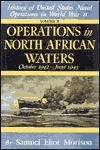What do you think?
Rate this book


This second volume, actually the first to be published, covers naval aspects of Operation "Torch," the North African campaign, which carried out the plan favored by President Roosevelt for opening a second front to relieve the Russians. Told with the accuracy of a historian, the pace of an experienced narrator, the detail of firsthand observation and participation, it is a full record of what was, at the time it occurred, the largest overseas expedition ever undertaken.
440 pages, cloth
First published March 23, 2001